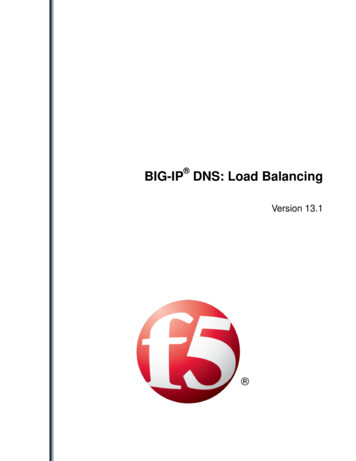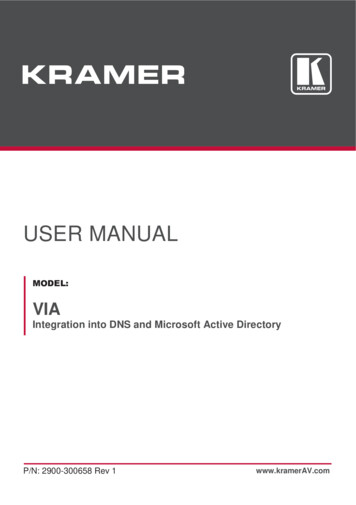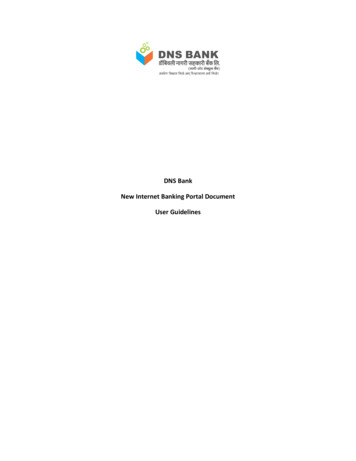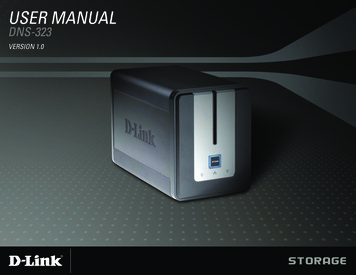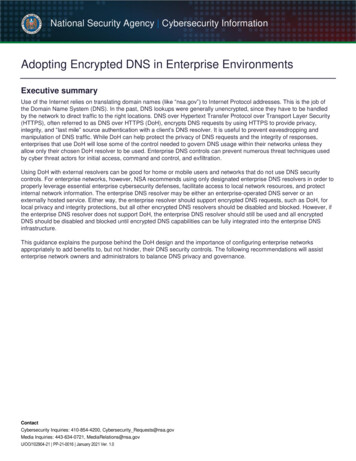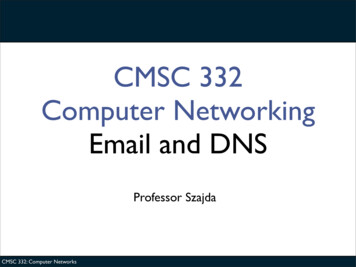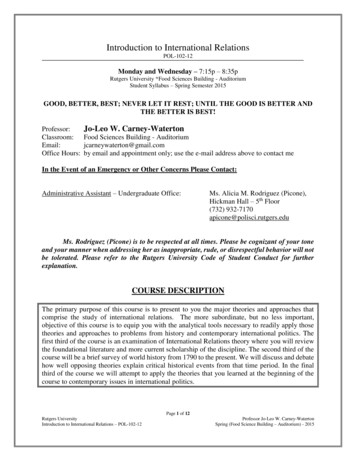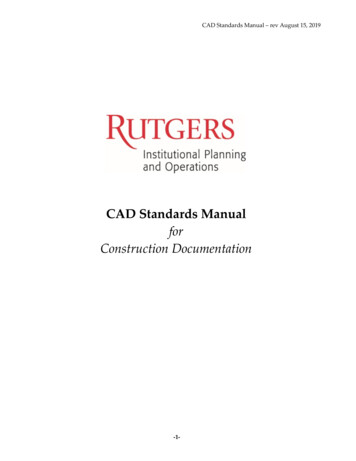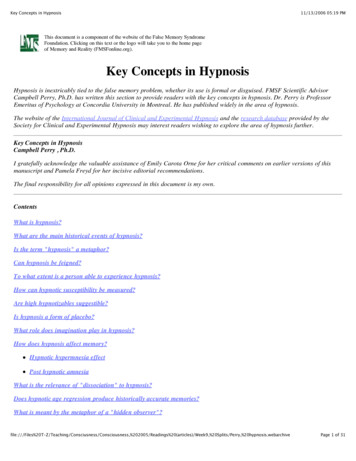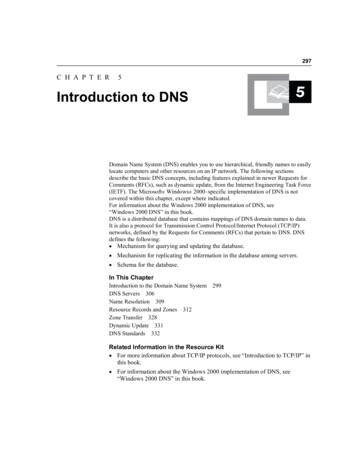
Transcription
297C H A P T E R5Introduction to DNSDomain Name System (DNS) enables you to use hierarchical, friendly names to easilylocate computers and other resources on an IP network. The following sectionsdescribe the basic DNS concepts, including features explained in newer Requests forComments (RFCs), such as dynamic update, from the Internet Engineering Task Force(IETF). The Microsoft Windows 2000–specific implementation of DNS is notcovered within this chapter, except where indicated.For information about the Windows 2000 implementation of DNS, see“Windows 2000 DNS” in this book.DNS is a distributed database that contains mappings of DNS domain names to data.It is also a protocol for Transmission Control Protocol/Internet Protocol (TCP/IP)networks, defined by the Requests for Comments (RFCs) that pertain to DNS. DNSdefines the following: Mechanism for querying and updating the database. Mechanism for replicating the information in the database among servers. Schema for the database.In This ChapterIntroduction to the Domain Name System 299DNS Servers 306Name Resolution 309Resource Records and Zones 312Zone Transfer 328Dynamic Update 331DNS Standards 332Related Information in the Resource Kit For more information about TCP/IP protocols, see “Introduction to TCP/IP” inthis book. For information about the Windows 2000 implementation of DNS, see“Windows 2000 DNS” in this book.
298Part 2Address Allocation and Name ResolutionIntroduction to the Domain Name SystemAlthough TCP/IP uses IP addresses to locate and connect to hosts (computers andother TCP/IP network devices), users typically prefer to use friendly names. Forexample, users prefer the friendly name ftp.reskit.com, instead of its IP address,172.16.23.55. The Domain Name System (DNS), defined in RFCs 1034 and 1035, isused on the Internet to provide a standard naming convention for locating IP-basedcomputers.On the Internet, before the implementation of DNS, the use of names to locateresources on TCP/IP networks was supported by a file called Hosts. Networkadministrators entered names and IP addresses into Hosts, and computers used the filefor name resolution.Both the Hosts file and DNS use a namespace. A namespace is a grouping in whichnames can be used to symbolically represent another type of information, such as anIP address, and in which specific rules are established that determine how names canbe created and used. Some namespaces, such as DNS, are hierarchically structuredand provide rules that allow for the namespace to be divided into subsets of names fordistributing and delegating parts of the namespace. Other namespaces, such as theHosts namespace cannot be divided and must be distributed in their entirety. Becauseof this, using the Hosts file posed a problem for network administrators. As thenumber of computers and users on the Internet grew, the task of updating anddistributing the Hosts file became unmanageable.DNS replaces the Hosts file with a distributed database that implements a hierarchicalnaming system. This naming system allows for growth on the Internet and the creationof names that are unique throughout the Internet and private TCP/IP-based intranets.Domain NamespaceThe naming system on which DNS is based is a hierarchical and logical tree structurecalled the domain namespace. Organizations can also create private networks that arenot visible on the Internet, using their own domain namespaces. Figure 5.1 shows partof the Internet domain namespace, from the root domain and top-level Internet DNSdomains, to the fictional DNS domain named reskit.com that contains a host(computer) named Mfgserver.
Chapter 5Introduction to DNS299Managed byInternet authority“ ”(Root)comeduorgOtherTop-levelDomainTop-level InternetDomainsreskitMfgserverReskitDomainFigure 5.1Domain Name SystemEach node in the DNS tree represents a DNS name. Some examples of DNS namesare DNS domains, computers, and services. A DNS domain is a branch under thenode. For example, in Figure 5.1, reskit.com is a DNS domain. DNS domains cancontain both hosts (computers or services) and other domains (referred to assubdomains). Each organization is assigned authority for a portion of the domainnamespace and is responsible for administering, subdividing, and naming the DNSdomains and computers within that portion of the namespace.Subdividing is an important concept in DNS. Creating subdivisions of the domainnamespace and private TCP/IP network DNS domains supports new growth on theInternet and the ability to continually expand name and administrative groupings.Subdivisions are generally based on departmental or geographic divisions.For example, the reskit.com DNS domain might include sites in North America andEurope. A DNS administrator of the DNS domain reskit.com can subdivide thedomain to create two subdomains that reflect these groupings: noam.reskit.com. andeu.reskit.com. Figure 5.2 shows an example of these subdomains.
300Part 2Address Allocation and Name Resolution“”(Root)comreskitnoamFigure 5.2euSubdomainsDomain NameComputers and DNS domains are named based on their position in the domain tree.For example, because reskit is a subdomain of the .com domain, the domain name forreskit is reskit.com.Every node in the DNS domain tree can be identified by a fully qualified domainname (FQDN). The FQDN is a DNS domain name that has been statedunambiguously so as to indicate with absolute certainty its location relative to the rootof the DNS domain tree. This contrasts with a relative name, which is a name relativeto some DNS domain other than the root.For example, the FQDN for the server in the reskit.com DNS domain is constructed asMfgserver.reskit.com., which is the concatenation of the host name (Mfgserver) withthe primary DNS suffix (reskit.com), and the trailing dot (.). The trailing dot is astandard separator between the top-level domain label and the empty string labelcorresponding to the root.Note In general, FQDNs have naming restrictions that allow only the use ofcharacters a-z, A-Z, 0-9, and the dash or minus sign (-). The use of the period(.) is allowed only between domain name labels (for example, “reskit.com”) or at theend of a FQDN. Domain names are not case-sensitive.You can configure the Windows 2000 DNS server to enforce some or all RFCcharacter restrictions or to ignore all character restrictions. For more information, see“Windows 2000 DNS” in this book.Internet Domain NamespaceThe root (the top-most level) of the Internet domain namespace is managed by anInternet name registration authority, which delegates administrative responsibility forportions of the domain namespace to organizations that connect to the Internet.Beneath the root DNS domain lie the top-level domains, also managed by the Internetname registration authority. There are three types of top-level domains: Organizational domains. These are named by using a 3-character code thatindicates the primary function or activity of the organizations contained within
Chapter 5Introduction to DNS301the DNS domain. Organizational domains are generally only for organizationswithin the United States, and most organizations located in the United Statesare contained within one of these organizational domains. Geographical domains. These are named by using the 2-charactercountry/region codes established by the International Standards Organization(ISO) 3166. Reverse domains. This is a special domain, named in-addr.arpa, that is used forIP address-to-name mappings (referred to as reverse lookup). For moreinformation, see “Name Resolution” later in this chapter. There is also aspecial domain, named IP6.INT, used for IP version 6 reverse lookups. Forinformation, see RFC 1886.The most commonly used top-level DNS name components for organizations in theUnited States are described in the Table 5.1.Table 5.1Top-Level Name Component of the DNS HierarchyTop-LevelNameComponentDescriptionExample DNSDomain Name.comAn Internet name authority delegates portions of thedomain namespace under this level to commercialorganizations, such as the Microsoft Corporation.microsoft.com.eduAn Internet name authority delegates portions of thisdomain namespace to educational organizations, suchas the Massachusetts Institute of Technology (MIT).mit.edu.govAn Internet name authority delegates portions of thisdomain namespace to governmental organizations,such as the White House in Washington, D.C.whitehouse.gov.intAn Internet name authority delegates portions of thisdomain namespace to international organizations, suchas the North Atlantic Treaty Organization (NATO).nato.int.milAn Internet name authority delegates portions of thisdomain namespace to military operations, such as theDefense Date Network (DDN).ddn.mil(continued)Table 5.1Top-Level Name Component of the DNS Hierarchy e DNSDomain Name.netAn Internet name authority delegates portions of thisdomain namespace to networking organizations, suchas the National Science Foundation (NSF).nsf.net.orgAn Internet name authority delegates portions of thisdomain namespace to noncommercial organizations,such as the Center for Networked Informationcnidr.org
302Part 2Address Allocation and Name ResolutionDiscovery and Retrieval (CNIDR).In addition to the top-level domains listed above, individual countries have their owntop-level domains. For example, .ca is the top-level domain for Canada.Beneath the top-level domains, an Internet name authority delegates domains toorganizations that connect to the Internet. The organizations to which an Internetname authority delegates a portion of the domain namespace are then responsible fornaming the computers and network devices within their assigned domain and itssubdivisions. These organizations use DNS servers to manage the name-to-IP addressand IP address-to-name mappings for host devices contained within their portion ofthe namespace.Basic DNS ConceptsThis section provides brief definitions of additional DNS concepts, which aredescribed in more detail in the following sections of this chapter.DNS servers. Computers that run DNS server programs containing DNS databaseinformation about the DNS domain tree structure. DNS servers also attempt to resolveclient queries. When queried, DNS servers can provide the requested information,provide a pointer to another server that can help resolve the query, or respond that itdoes not have the information or that the information does not exist.DNS resolvers. Programs that use DNS queries to query for information from servers.Resolvers can communicate with either remote DNS servers or the DNS serverprogram running on the local computer. Resolvers are usually built into utilityprograms or are accessible through library functions. A resolver can run on anycomputer, including a DNS server.Resource records. Sets of information in the DNS database that can be used to processclient queries. Each DNS server contains the resource records it needs to answerqueries for the portion of the DNS namespace for which it is authoritative. (A DNSserver is authoritative for a contiguous portion of the DNS namespace if it containsinformation about that portion of the namespace.)Zones. Contiguous portions of the DNS namespace for which the server isauthoritative. A server can be authoritative for one or more zones.Zone files. Files that contain resource records for the zones for which the server isauthoritative. In most DNS implementations, zones are implemented as text files.ZonesA zone is a contiguous portion of the DNS namespace. It contains a series of recordsstored on a DNS server. Each zone is anchored at a specific domain node. However,zones are not domains. A DNS domain is a branch of the namespace, whereas a zoneis a portion of the DNS namespace generally stored in a file, and can contain multipledomains. A domain can be subdivided into several partitions, and each partition, orzone, can be controlled by a separate DNS server. Using the zone, the DNS serveranswers queries about hosts in its zone, and is authoritative for that zone. Zones canbe primary or secondary. A primary zone is the copy of the zone to which the updates
Chapter 5Introduction to DNS303are made, whereas a secondary zone is a copy of the zone that is replicated from amaster server.Zones can be stored in different ways. For example, they can be stored as zone files.On Windows 2000 servers, they can also be stored in the Active Directory directoryservice. Some secondary servers store them in memory and perform a zone transferwhenever they are restarted.Figure 5.3 shows an example of a DNS domain that contains two primary zones. Inthis example, the domain reskit.com contains two subdomains: noam.reskit.com. andeu.reskit.com. Authority for the noam.reskit.com. subdomain has been delegated tothe server noamdc1.noam.reskit.com. Thus, as Figure 5.3 shows, one server,noamdc1.noam.reskit.com, hosts the noam.reskit.com zone, and a second server,reskitdc1.reskit.com, hosts the reskit.com zone that includes the oamnoamdc1reskit.comzonenoam.reskit.comzoneFigure 5.3Domains and ZonesRather than delegating the noam.reskit.com zone to noamdc1.noam.reskit.com, theadministrator can also configure reskitdc1 to host the zone for noam.reskit.com.Also, you cannot configure two different servers to manage the same primary zones;only one server can manage the primary zone for each DNS domain. There is oneexception: multiple computers can manage Windows 2000 Active Directory–integrated zones. For more information, see “Windows 2000 DNS” in this book.You can configure a single DNS server to manage one zone or multiple zones,depending on your needs. You can create multiple zones to distribute administrativetasks to different groups and to provide efficient data distribution. You can also storethe same zone on multiple servers to provide load balancing and fault tolerance.
304Part 2Address
A server can be authoritative for one or more zones. Zone files. Files that contain resource records for the zones for which the server is authoritative. In most DNS implementations, zones are implemented as text files. Zones A zone is a contiguous portion of the DNS namespace. It contains a series of records stored on a DNS server. Each zone is anchored at a specific domain node. However .
